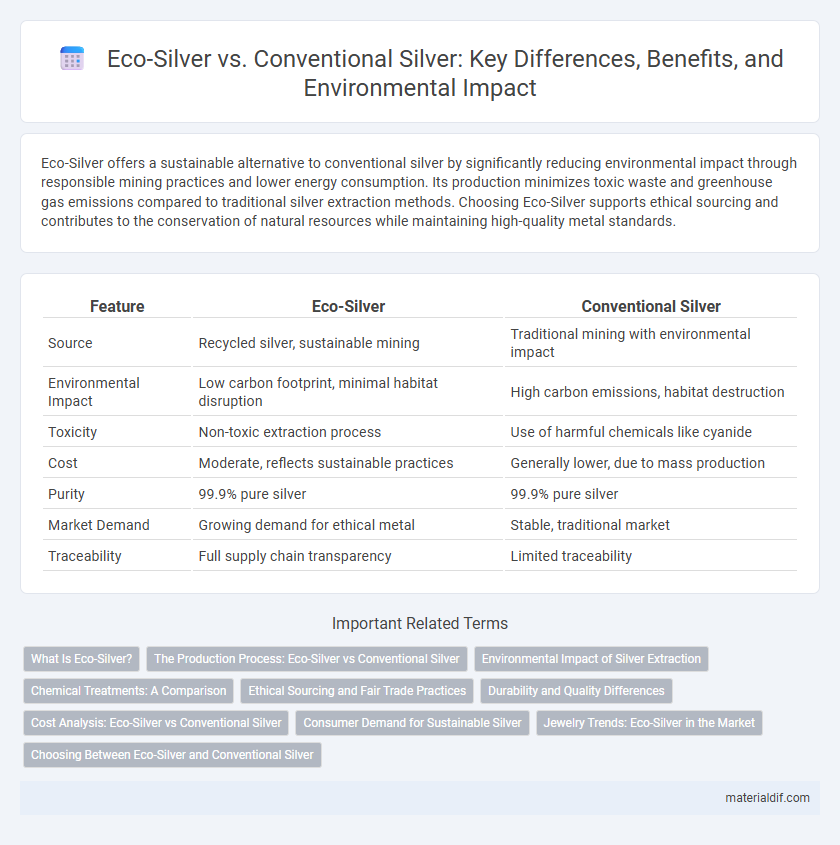Eco-Silver offers a sustainable alternative to conventional silver by significantly reducing environmental impact through responsible mining practices and lower energy consumption. Its production minimizes toxic waste and greenhouse gas emissions compared to traditional silver extraction methods. Choosing Eco-Silver supports ethical sourcing and contributes to the conservation of natural resources while maintaining high-quality metal standards.
Table of Comparison
| Feature | Eco-Silver | Conventional Silver |
|---|---|---|
| Source | Recycled silver, sustainable mining | Traditional mining with environmental impact |
| Environmental Impact | Low carbon footprint, minimal habitat disruption | High carbon emissions, habitat destruction |
| Toxicity | Non-toxic extraction process | Use of harmful chemicals like cyanide |
| Cost | Moderate, reflects sustainable practices | Generally lower, due to mass production |
| Purity | 99.9% pure silver | 99.9% pure silver |
| Market Demand | Growing demand for ethical metal | Stable, traditional market |
| Traceability | Full supply chain transparency | Limited traceability |
What Is Eco-Silver?
Eco-Silver refers to silver sourced through environmentally responsible mining practices that minimize ecological impact, reduce chemical use, and ensure fair labor conditions. Unlike conventional silver mining, which often involves harmful chemicals like cyanide and mercury, Eco-Silver emphasizes sustainable extraction methods and recycling of silver from electronic waste. This approach supports conservation efforts, reduces pollution, and promotes ethical standards throughout the silver supply chain.
The Production Process: Eco-Silver vs Conventional Silver
Eco-silver production minimizes environmental impact by using recycled silver and non-toxic processes, significantly reducing mining waste and chemical pollution compared to conventional silver extraction. Conventional silver mining relies heavily on open-pit mining and the use of cyanide and mercury, which contaminate soil and water ecosystems. Advancements in eco-friendly refining techniques ensure sustainable resource use and lower carbon emissions in the overall silver production cycle.
Environmental Impact of Silver Extraction
Eco-silver extraction utilizes sustainable methods such as recycling and low-impact mining techniques that significantly reduce soil contamination and water pollution compared to conventional silver mining. Conventional silver extraction often involves toxic chemicals like cyanide and mercury, leading to hazardous waste and damage to local ecosystems. Shifting to eco-friendly silver production promotes biodiversity preservation and lowers carbon emissions associated with traditional silver mining processes.
Chemical Treatments: A Comparison
Eco-Silver undergoes minimal chemical treatments using non-toxic agents and water-based processes that reduce environmental impact and heavy metal contamination. Conventional silver involves harsher chemical treatments including cyanide leaching and toxic solvents that pose significant risks to soil and water quality. Selecting eco-silver supports sustainable mining practices by minimizing the release of harmful chemicals during extraction and refining.
Ethical Sourcing and Fair Trade Practices
Eco-Silver is sourced through certified ethical mining practices that prioritize environmental sustainability and fair labor conditions, minimizing ecological impact and supporting local communities. Conventional silver often lacks transparency in its supply chain, with potential links to exploitative labor and environmental degradation. Fair trade certification for Eco-Silver ensures equitable wages, safe working environments, and adherence to strict environmental standards, setting it apart from traditional silver production.
Durability and Quality Differences
Eco-Silver, produced through sustainable mining practices and recycled materials, offers comparable durability to conventional silver while reducing environmental impact. Its quality meets industry standards with similar hardness, resistance to tarnish, and longevity in jewelry and industrial applications. Conventional silver may have marginally higher purity but often involves environmentally harmful extraction methods.
Cost Analysis: Eco-Silver vs Conventional Silver
Eco-Silver typically incurs higher upfront costs due to sustainable mining practices and ethical sourcing, which emphasize environmental conservation and worker safety. Conventional silver benefits from established extraction methods and economies of scale, resulting in lower production expenses but often at the cost of environmental degradation. Over time, Eco-Silver may offer cost savings in regulatory compliance and brand value, potentially offsetting initial price differences.
Consumer Demand for Sustainable Silver
Consumer demand for sustainable silver, such as eco-silver, has surged due to increased awareness of environmental impact and ethical sourcing. Eco-silver is produced using environmentally friendly methods, minimizing habitat destruction and reducing carbon emissions compared to conventional silver mining. Retailers and jewelers report higher sales and loyalty from customers prioritizing eco-silver certifications and traceability in their purchases.
Jewelry Trends: Eco-Silver in the Market
Eco-silver jewelry is gaining momentum by combining sustainability with high-quality craftsmanship, appealing to environmentally conscious consumers seeking ethical alternatives to conventional silver. This trend emphasizes recycled or responsibly sourced silver, reducing environmental impact and promoting transparency in the supply chain. Market demand for eco-silver reflects a broader shift toward sustainable luxury, influencing designers and retailers to prioritize eco-friendly materials in their collections.
Choosing Between Eco-Silver and Conventional Silver
Eco-silver is sourced from recycled materials and mined using environmentally responsible methods, reducing ecological impact and conserving natural resources. Conventional silver mining often involves higher energy consumption, toxic chemical use, and habitat disruption, contributing to pollution and biodiversity loss. Choosing eco-silver supports sustainable practices, lowers carbon footprint, and promotes ethical supply chains in the silver industry.
Eco-Silver vs Conventional Silver Infographic

 materialdif.com
materialdif.com